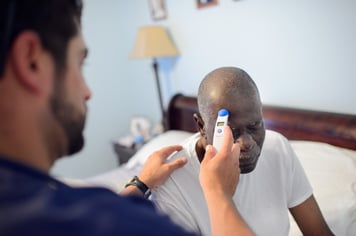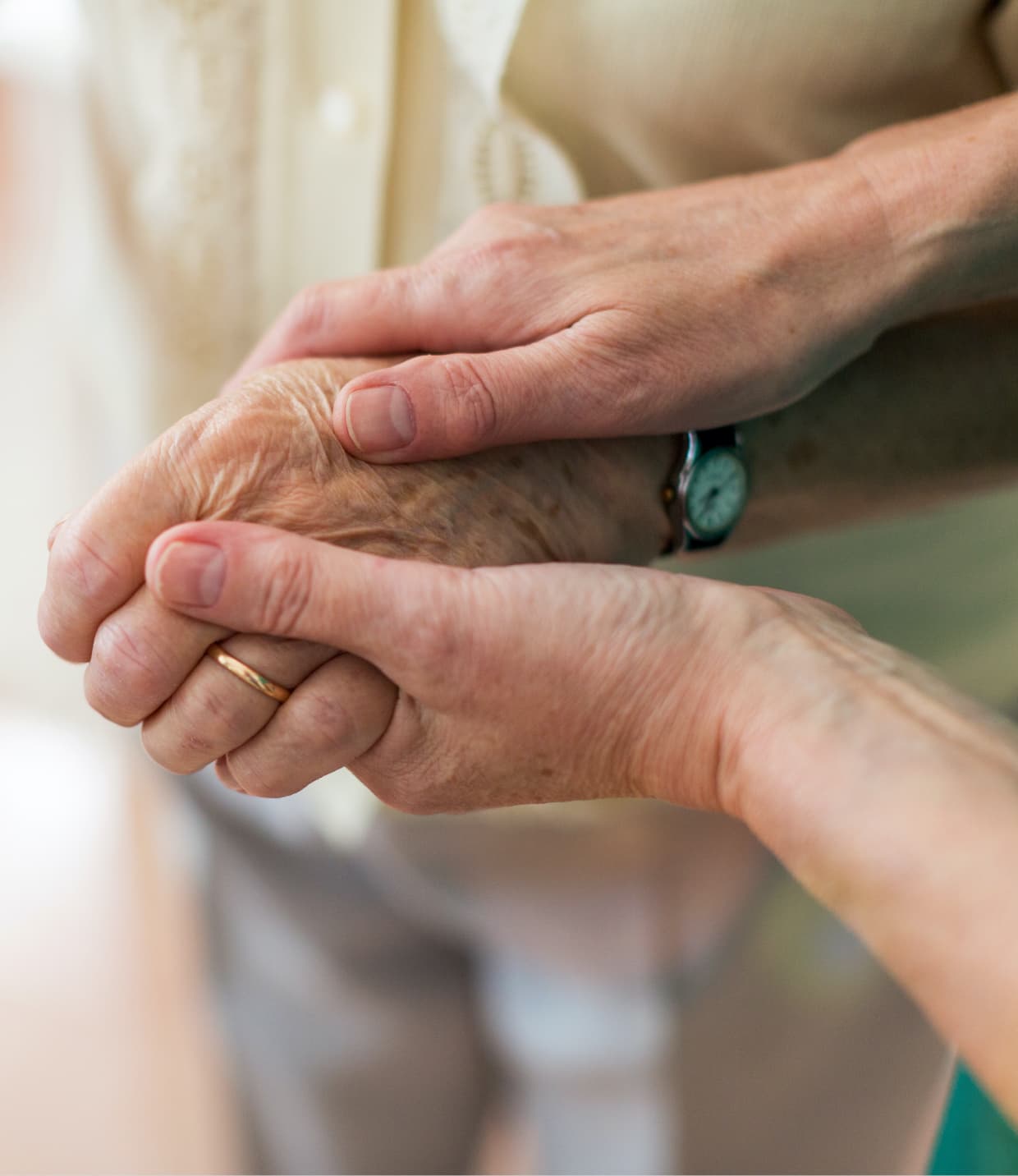Diabetes mellitus, or just diabetes, is a group of diseases characterized by high blood sugar caused by defects in insulin generation and/or action. Chronic high blood sugar can result in long-term damage, dysfunction and even failure of key organs like the eyes, kidneys, nerves heart and blood vessels.
Type 2 diabetes accounts for as much as 95 percent of cases and affects approximately 20 percent of Americans aged 65 and older1.
Effectively managing diabetes can help patients maintain a healthier lifestyle and help prevent more serious conditions like heart failure, high blood pressure, stroke, wounds and kidney disease.
What is a Nursing Care Plan?
Nursing care plans allow nurses, patients and other medical professionals to stay on the same page with coordinated care, goals and outcomes. While plans will vary among providers and organizations, most include the core components of patient diagnoses, desired outcomes, nursing orders and subsequent evaluation.
In home health care specifically, the agency care team and the physician establish a set plan of care that includes and outlines:
- The types of services you need, which may include skilled nursing, physical therapy, occupational therapy, social work, home health aides and more
- How often you need these services
- Any home medical equipment you may need
- Any specific dietary requirements
- Your doctor’s goal for the treatment
Goals for Diabetes Patients in Home Health Care
While every patient will have a unique treatment plan and goals, these are the most common goals for successful diabetes management:
- Teaching healthy habits to control glucose levels and prevent complications
- Empowering patients to understand and monitor diabetes symptoms
- Managing medications
- Improving functional strength and mobility
- Establishing a daily exercise routine to match pace and ability level
- Achieving goals and improving quality of life
- Reducing hospitalizations related to diabetes complications
How Does Home Health Nursing Help Patients with Diabetes?
Skilled nursing care is the most common home health service and serves as an essential component in helping patients manage diabetes at home.
Home health professionals help educate patients on how they can take control of their own health to manage the disease through appropriate dieting, exercising and self-monitoring for signs of dangerously high or low blood sugar. They also monitor key metrics like glucose levels, ensure medication adherence and establish nutrition and activity-level goals.
Specifically, home health nurses and other members of the interdisciplinary team focus on the following:
Assessing Glycemic Control
Glycemic control is the delicate balancing act of keeping blood sugar levels within a normal range and, if successful, can reduce microvascular complications like nerve, eye or kidney problems.
Physicians identify each patient’s individual glucose goals based on factors like the duration of diabetes, age and life expectancy, comorbid conditions, known microvascular complications and other patient-by-patient considerations.
Leading organizations like the American Diabetes Association (ADA), the American Association of Clinical Endocrinologists (AACE) and the International Diabetes Federation (IDF) each have their own recommendations on goals as measured by A1C% and pre- and post-meal blood glucose levels.
The home health team and doctor will assess each patient’s medical condition and ability to effectively participate in managing their glucose.
Glucose Monitoring
Glucose monitoring is an essential skill for managing diabetes and assessing treatment outcomes. Continuous information on blood sugar levels, collected at home, helps the home health team and physician assess patients’ progress and ability to live with this chronic disease.
The frequency of at-home, self-administered glucose testing depends on the treatment plan, plan of care goals, financial limitations and patients’ ability and willingness to test.
[action 2]
Home health professionals will help each patient understand how often they should check their glucose levels, how to get the right equipment, how to perform the tests and act on the results.
Medication Management
Drug therapy is a key component of diabetes management by mimicking the body’s natural process of metabolizing and using glucose. For type 2 diabetes patients, oral medication is adequate. The home health team will help the patient balance the need for medication with other lifestyle changes like weight loss, diet changes, increased activity and less carb consumption.
For type 1 diabetes patients and some type 2 diabetes patients, injection therapies, including insulin injection, can be used if oral medication is not doing the trick or the patient is undergoing surgery, another illness or pregnancy.
Home health nurses will help the patient understand both the type of medication therapy they need and the correct dosage. As part of the first home health visit, clinicians will assess whether they believe the patient or caregiver to be capable of self-administering injections based on cognitive or vision impairments.
Nutrition Therapy
Nutrition therapy can help improve glucose levels by as much as 2 percent2, comparable to oral medications, and has the following goals:
- Promote and support healthful eating patterns with emphasis on a variety of nutrient-dense food in appropriate portion sizes to improve health and attain goals
- Achieve and maintain desired body weight
- Delay or prevent diabetes-related complications
- Address individual nutrition needs based on personal or cultural preferences, health literacy, access to healthy food choices and more
- Provide patients with practical day-to-day meal planning tools
In the early stages of type 2 diabetes, losing weight is the primary goal. Research3 shows that losing 5 to 10 percent of body weight can significantly improve glucose control.
The home health team will educate the patient on successful, practical weight loss strategies like switching from calorie-heavy drinks to diet sodas or sugar-free drink mixes, changing snacks from packaged products to fruits and vegetables, decreasing portion sizes and eating at home more frequently.
Moderating carbohydrate intake is also critical to nutrition therapy. Successful carb moderation is not eliminating them entirely, but rather consuming the right kinds, like fruits and whole grains, in the appropriate balance with fat and protein.
The “Plate Method” helps patients visualize what an appropriate meal should look like to meet the goals. In this method, half of the plate should be filled with non-starchy vegetables, a quarter with a starch and the final quarter with a protein. Adding a serving of fruit is also recommended.
Increasing Physical Activity
Regular exercise can improve long-term glycemic control and help reduce the need for insulin or other medications. It can also help reduce stress, help maintain a healthy weight, lower fat levels in the blood, reduce the risk of heart disease and promote overall health. Any exercise regimen should be individualized to the patient and have sign-off from the physician.
The home health team will often encourage patients to increase their activity levels, starting as little as 10 minutes a day 3 to 5 times a week, increasing gradually to as much as 45 minutes on most days. A combination of aerobic exercise, like walking, and strength training is recommended for the greatest benefit. Patients are also encouraged to have a caregiver or family member accompany them in walks or other forms of exercise to improve the experience and commitment.
Home health clinicians will also help patients navigate any specific challenges to exercise and remind them to check glucose levels before beginning any activity.
Amedisys' Diabetes Program
Amedisys home health agencies offer an evidence-based diabetes management empowerment program for patients whose primary diagnosis is diabetes. Specifically, the Amedisys program:
- Engages patients in self-care to better manage symptoms at home and identify early signs of complications
- Addresses other illnesses like heart failure and high blood pressure
- Teaches how to monitor blood sugar levels and recognize signs of diabetes-related complications
- Provides home health diabetes teaching on healthy habits including lifestyle changes, wellness, diet, exercise and medication management.
The full, interdisciplinary team of clinicians work together to help patients meet the individualized goals. Outside of skilled nursing, occupational, physical and speech therapists help to improve function, encourage adherence to the care plan, reinforce education and reduce falls and injuries.
Medical social workers help with navigating financial assistance, community resources and education on social and emotional impacts of managing diabetes.
Home health aides assist with activities of daily living like bathing, grooming and dressing and serve as an extra set of eyes and ears to report changes and progress to the rest of the team.
If you believe you, your loved one or your patient might benefit from home health care and the diabetes program, call a location near you to get in touch with a home health specialist.
References:
1National Diabetes Statistics Report: Estimates of Diabetes and Its Burden in the United States2017.(2017). Retrieved from Centers for Disease Control and Prevention, Atlanta Georgia: U.S. Department of Health and Human Services.
2Sick Day Management Using Blood 3-hydroxybutyrate (3-OHB) Compared with Urine Ketone Monitoring Reduces Hospital visits in Young People with T1DM: a Randomized Clinical Trial. (2006 March; vol. 23(3)). Diabetes Medicine: A Journal of the British Diabetic Association, pp.278-84.
3Parks-Chapman, J.., & March, P. (2018, November 9). Diabetes Mellitus, Type 2: Weight Management. Retrieved from CINAHL Nursing Guide, EBSCO Publishing #701300: http://search.ebscohost.com/login.aspx?direct=true&db=npr&AN=T701300&site=nrc-perc





